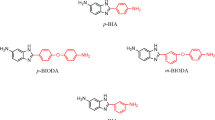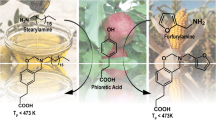Abstract
Bio-based polybenzoxazoles (PBOs) are prepared by polycondensation of diacid monomer derived from 3-amino-4-hydroxybenzoic acid with a series of aliphatic diamines. Resulting bio-based PBOs have high weight average molecular weight ranging 5.70–7.20 × 104 g/mol and show ultrahigh thermal resistance with T 10 values over 400 °C and T g values over 170 °C, which are higher than those of conventional bio-based polymers, polyamides 11 (around 60 °C) or poly(lactic acid) (56 °C). Especially hydrazide group of the bio-based PBO were cyclized to form diazole ring by annealing at 330 °C for 20 min. The resultant PBO show liquid crystalline (LC) behavior to spin fiber in a melting state. The resultant PBO fibers showed high values of Young’s modulus and mechanical strength as compared with conventional polymers polyamide 11 and poly(lactic acid) (PLA).






Similar content being viewed by others
References
Kaneko T, Thi TH, Shi DJ, Akashi M (2006) Environmentally degradable, high-performance thermoplastics from phenolic phytomonomers. Nat Mater 5:966–970
Iwata T (2015) Biodegradable and bio-based polymers: future prospects of eco-friendly plastics. Angew Chem Int Ed 54:3210–3215
Ali MA, Tateyama S, Oka Y, Kaneko D, Okajima MK, Kaneko T (2013) Syntheses of high-performance biopolyamides derived from itaconic acid and their environmental corrosion. Macromolecules 46:3719–3725
Nagarajan V, Mohanty AK, Misra M (2016) Perspective on Polylactic acid (PLA) based sustainable materials for durable applications: focus on toughness and heat resistance ACS sustainable. Chem Eng 4:2899–2916
Ali MA, Kaneko T (2015) Polyamide synthesis. In: Kobayashi S, Mullen K (eds) Encyclopedia of polynanomeric materials. Springer, Berlin, pp. 1750–1762
Ali MA, Tateyama S, Kaneko T (2014) Syntheses of rigid-rod but degradable biopolyamides from itaconic acid with aromatic diamines. Polym Degrad Stab 109:367–372
Gupta P, Trenor SR, Long TE, Wilkes GL (2004) In situ photo-cross-linking of Cinnamate functionalized poly(methylmethacrylate-co-2-hydroxyethyl acrylate) fibers during electrospinning. Macromolecules 37:9211–9218
Wang SQ, Kaneko D, Okajima M, Yasaki K, Tateyama S, Kaneko T (2013) Hyperbranched Polycoumarates with photofunctional multiple shape memory. Angew Chem Int Ed 52:11143–11148
Suvannasara P, Tateyama S, Miyasato A, Matsumura K, Shimoda T, Ito T, Yamagata Y, Fujita T, Takaya N, Kaneko T (2014) Biobased polyimides from 4-Aminocinnamic acid Photodimer. Macromolecules 47:1586–1593
Kumar A, Tateyama S, Yasaki K, Ali MA, Takaya N, Singh R, Kaneko T (2016) Ultrahigh performance bio-based polyimides from 4,4′-diaminostilbene. Polymer 83:182–189
Tsuge Y, Kawaguchi H, Sasaki K, Kondo A (2016) Engineering cell factories for producing building block chemicals for bio-polymer synthesis. Microb Cell Factories 15:19
Gould SJ, Melville CR, Cone MC (1996) 3-Amino-4-hydroxybenzoic acid is derived from the tricarboxylic acid cycle rather than the Shikimic acid pathway. J Am Chem Soc 118:9228–9232
Kawaguchi H, Sasaki K, Uematsu K, Tsuge Y, et al. (2015) 3-Amino-4-hydroxybenzoic acid production from sweet sorghum juice by recombinant Corynebacterium glutamicum. Bioresour Technol 198:410–417
Kan K, Kaneko D, Kaneko T (2011) Polarized emission of wholly aromatic bio-based Copolyesters of a liquid crystalline nature. Polymers 3:861–874
Kan K, Yamamoto H, Kaneko D, Tateyama S, Kaneko T (2014) Novel π-conjugated bio-based polymer, poly(3-amino-4-hydroxybenzoic acid), and its solvatochromism. Pure Appl Chem 86:685–690
Fukumaru T, Fujigaya T, Nakashima N (2013) Mechanical reinforcement of Polybenzoxazole by carbon nanotubes through noncovalent functionalization. Macromolecules 46:4034–4040
Guo R, Sanders DF, et al. (2013) Synthesis and characterization of thermally rearranged (TR) polymers: effect of glass transition temperature of aromatic poly(hydroxyimide) precursors on TR process and gas permeation properties. J Mater Chem A 1:6063–6072
Wang M, Wang C, Song Y, **e H, Huang Y (2017) One-pot in situ polymerization of graphene oxide nanosheets and poly(p-phenylenebenzobisoxazole) with enhanced mechanical and thermal properties. Compos Sci Technol 14:16–23
Acknowledgments
This study was financially supported by JST CREST (JPMJCR13B3).
Author information
Authors and Affiliations
Corresponding author
Additional information
This article is part of the Topical Collection on Bio-Based Polymers
Electronic supplementary material
ESM 1
(DOC 1775 kb)
Rights and permissions
About this article
Cite this article
Ali, M.A., Shimosegawa, H., Nag, A. et al. Synthesis of thermotropic polybenzoxazole using 3-amino-4-hydroxybenzoic acid. J Polym Res 24, 214 (2017). https://doi.org/10.1007/s10965-017-1362-9
Received:
Accepted:
Published:
DOI: https://doi.org/10.1007/s10965-017-1362-9




